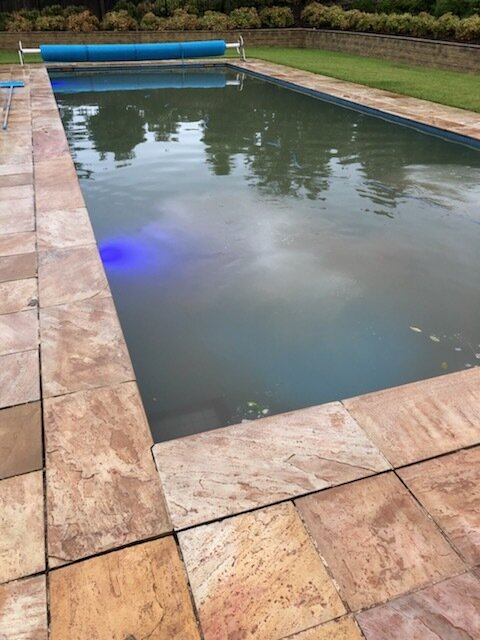Heavy Rain in Victoria affecting swimming pools
Large amounts of dust and dirt can be brought in with the rain when the winds come from the north. This dirt causes a few issues for pools ranging from dirty water, chemical imbalances & high phosphate levels that can encourage algae growth, along with the additional water going into the pool and potential overflowing issues.
Raindrops form by water vapour attaching to microscopic dust, dirt, pollen and algae spores present in the air, the combine together until they’re big enough to fall as rain. It’s these spores and other material in the raindrops that get carried into the pool.
Additionally, when rainwater comes off your landscape or deck, you also have an added source of water and debris to deal with which can change your chemical levels, as well as bring more contaminants such as dirt and debris into the pool.
Heavy rains don't dilute the chemicals in your pool as an inch of rainwater added to a typical 50,000 litre pool only increases the amount of water by only about 1.5%, meaning dilution is not usually an issue. It's more about what comes into the pool with the rain.
So, what to do?
Poolside Beaconsfield owner Grant had his pool affected by the dirty rain
The first thing to do is to work out how bad the water is... If you only have a light dusting of dirt on the bottom of the pool, our suggestion is to switch the filtration system to manual and run for 24 hours with your cleaner attached, If you have a robotic cleaner this will help even further by providing additional filtration and keeping your skimmer baskets free for maximum water flow through your filter. Then have your water balanced and backwash/clean the filter as required. If this doesn’t clear the pool or it’s very brown and you can't see the bottom, you'll most likely need to do a full 'floccing' treatment (read the brown pool tips below).
The extra debris added to the pool with rainfall can affect the pool water chemistry. For this reason, it is important that you test your water after it rains and re-balance where necessary. Bring in a water sample for us to check your phosphate levels as it is important to keep these low, otherwise you run the risk of an algae problem occurring.
HOW TO LOWER POOL LEVEL
After the rain has subsided, you may need to drain the excess water from the pool, to allow for proper skimming of the pool surface. If your filter has a multiport valve, follow these steps:
Turn off the pump,
Change the valve handle from filter onto WASTE (not backwash!),
Open any valves on the waste line,
Disconnect any suction cleaners & vacuum plates,
Then turn the pump back on to lower the water level,
Once the water level is halfway up the skimmer box,
Turn the pump off,
Return the multiport valve to FILTER,
Reconnect the cleaner and
Turn the pump back on (or set the timer to auto).
*do not do this if your pool requires floccing, you'll need all the water in the pool when vacuuming to waste.
Green Pool Treatment Guide
The solution is to make sure that the rate at which the algae in your pool are being killed is faster than the rate at which they are reproducing.
This means raising the sanitiser (chlorine) level up much higher than the ideal range, balancing the pH and adding an appropriate algaecide, clarifier and/or oxidiser. By adding these chemicals and running the filtration system for a minimum of 24 hours, this should return the pool to crystal clear again.
If you require help with any of these techniques please come into the store and speak with one of our experienced team or book your service online below.
BROWN POOL TREATMENT GUIDE
With very heavy rains, airborne dust, runoff from surrounding areas of the pool can add large amounts of dirt, soil and even mud into a pool. This will turn the pool into a messy brown soup with the inability to filter out.
This is where a floccing agent is used to bind the suspended particles together and drop them to the floor of the pool to make it easier to remove by vacuuming directly to waste. This requires a lot of water so keeping your pool water level as high as possible is important.
Turn your pump and filter off & remove any cleaners from the pool. If you have any chlorine on hand, add 5 x your normal dose around the pool. You can contact us to clean up your pool for you, alternatively you can come instore with a water sample and pick up the required chemicals and instructions.
